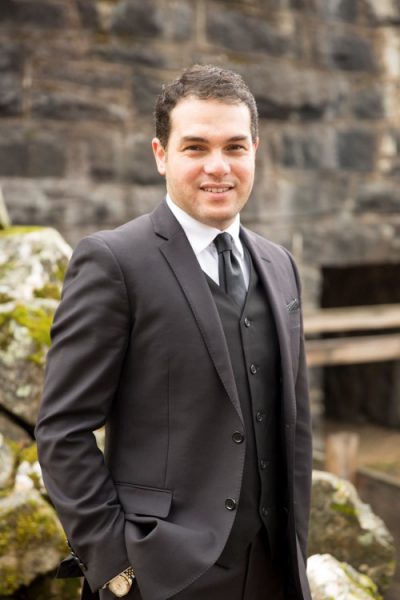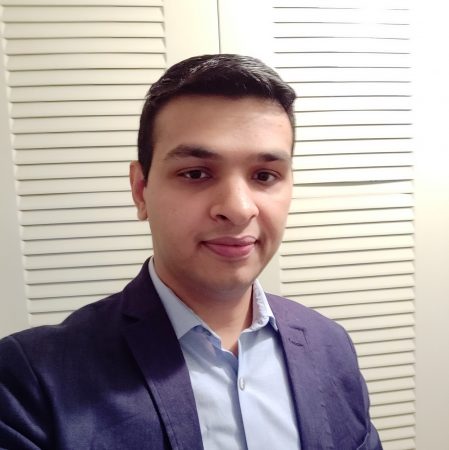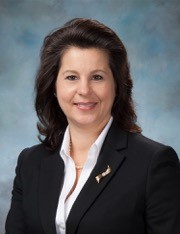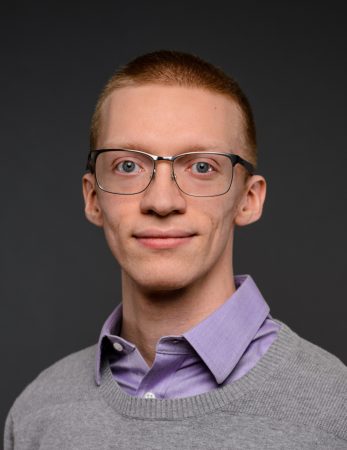Graduate Student Showcase 2020 Student Profiles
The annual Graduate Student Showcase moved to a virtual platform this year. The GradShow is a showcase of research, entrepreneurship and creativity. It is multi-day event for graduate students to present their work and talents, to connect with other graduate students and faculty at CSU, learn about other disciplines, and gain conference experience.
This year, five systems engineering Ph.D. students presented at the GradShow. Read on to learn more about their research and experience in the GradShow.

Moe Huss
Moe started his Ph.D. in 2018. He has finished all of his coursework and is now working on his dissertation research.
His GradShow presentation “System for grocery shopping recommendations based on one’s health profile” is based on his dissertation research project.
Moe won one of two Drivers of Innovation platinum awards from CSU Ventures. This award highlights the leading edge of the most innovative research originating from CSU research. Awardees in this category have presented innovative research capable of solving commercial needs that benefit society.
The vision of this research/product is to enable everyone to make informed and personalized grocery shopping that fits their medical conditions and health needs. In summary, “better dietary choices in every hand.”
Hekafy is a mobile/web application that is being developed to work like a dietician’s brain. But while the brain can analyze one or two things at a time, Hekafy takes a holistic view of one’s health conditions, analyzes tens of health inputs, and scientifically matches them to thousands of nutrition and grocery items.
You might be wondering what does “Hekafy” mean? Heka is the god of medicine in ancient Egypt.
Modern research continues to prove day after day, the significant impact of food on people’s health. Simply, we are what we eat.
“Let food be thy medicine, and let medicine be thy food.” This famous quote is often attributed to Hippocrates, the Greek founder of western medicine who died more than 2300 years ago. It mesmerizes me how accurate and valid this quote is.
Two reasons; first, I have been talking with users for a few months. I found the GradShow an excellent opportunity to get feedback from the CSU community. Second, I wanted to learn about the science and technology research the fellow Rams are working on.
The feedback I received during the GradShow confirmed what I heard from the previous users I talked with. There is a big need for this product in the market.
I want to take this opportunity to thank Dr. Butler and Dr. Borky for their continuous support to me throughout my Ph.D. journey.
I would love to continue receiving feedback from the CSU community on the product. Please visit https://hekafy.com and reach out to me at Mo.Hussein@colostate.edu.
If you are interested in being one of the early adopters of Hekafy, please let me know. We are working on a reward system for the early adopters.
Please remember that as an early adoptor, we will help you determine the best grocery items that fit your health needs.
Marija Krunic
Marija is currently in her second semester of her Ph.D. She has a master’s in biomedical sciences from CSU.
Her GradShow presentation “Keeping public restrooms COVID-19-free: Cell phone sanitizer and charger” was the result of a homework project for Human Systems Integration (ENGR581) in Spring 2020.
Marija won one of three Walter Scott, Jr. College of Engineering Excellence in Research Awards.
“Keeping Public Restrooms COVID-19 Free: Cell Phone Sanitizer and
Charger” was a homework project for ENGR 581 “Human Systems Integration” class taught by Dr. Erika Miller in Spring 2020.
Professor Miller wanted us to envision a device that would embody the principles and best practices of human system integration.
This assignment came just as the first wave of COVID-19 swept the nation so rather than just envision the device I decided to actually build one.
The device would not have been what it is today if it wasn’t for Professor Miller’s crucial and timely input: “Yes, the device will keep the phone from gathering germs by being handled in the bathroom but… can you make this thing sanitize the phone as well, Marija?”
Back to the drawing board. And shopping for sanitizing LED strips and components mid-COVID and getting it in time to submit before class deadline… talk about “supply-chain” nightmare. “Resourcefulness is key”, no joke. Learned a lot for sure.
Ever found yourself in the stall of a public bathroom with cell phone in hand? Right.
The design goal is to create a holder/shelving for a cell phone that would by it’s very design beckon the user to place the cell phone on it and override the modern urge to use the cell phone while on the toilet seat by offering add-on value other than just a place to set the phone down. Solution: Set it, charge it, sanitize it!
We have created such a device and demonstrated its use with a vision of aiding in the COVID-19 prevention and creating a device convenient and accessible to general public as well as elderly and vulnerable population. The device utilizes a hands-off inductive charging and germicidal UVC LED strips positioned to allow for complete device sanitation. The device represents a proof of concept and a functional prototype designed for contemporary look, durability and ease of installation and maintenance in a public setting.
The project offered an incredible opportunity to apply just learned Systems Engineering (SE) Methodology concepts and see them from the Human-Centered Development viewpoint. As much as a didactic part of education can bring to the table, nothing compares to actually getting a chance to apply that knowledge to something concrete.
Having to make the design decisions and “cut the metal” made the Systems Engineering process transparent, logical and approachable. I have started catching myself time and again actually thinking in SE terms (ex. “Which component to choose for this? … Functional Requirements… Operational Requirements… Subsystem Choice… right, form follows function!”).
The Human-Centered Design provided an understanding why interface design is so much more than will the two subsystems/components/elements fit together up to specks – user interfaces ultimately decide whether the entire system gets the thumbs up from the actual users. What a chance to put it all into practice!
I come from the Biomedical Sciences side of things. As a student new to Systems Engineering Dept. I wondered how well someone with my background might fit in. What a wonderful surprise to see so much interest, encouragement and support by everyone.
I have a M.S. from CSU hence a long-term love of all things Colorado State. After the main Campus got closed due to COVID I had an idea a month ago that if I got on my road bike I could pedal to Fort Collins from Boulder (“safer in the great outdoors” as CO Health Department stated), see my beloved Campus and get a good ride in.
This was my first time doing so and it was amazing to discover a fabulous trail system paralleling Taft and an incredible public artwork on the west side of Loveland. I highly recommend it!


Avpreet Othee
Avpreet is in his third year of his Ph.D. He successfully defended his preliminary Ph.D. exam last month.
His GradShow presentation “A modeling framework for electrical distributions containing harmonic producing loads” is related to his Ph.D. research. This research resulted in a Modelica-based library toolkit.
Avpreet won one of three Undergraduate Choice Awards for Research.
In a nutshell, my research stems from the DOE’s push towards energy efficiency, especially in commercial buildings.
Commercial buildings constitute a major portion of the energy consumption. One source of losses is the electrical losses in electronic converters. All the loads that we have in our household are DC loads, for example, your laptop, TV, phone charger, LED lights etc. These run on DC but the electricity we get from grid is AC.
This requires an AC to DC converter. The conversion from AC to DC results in losses. If we instead use a DC only distribution, research has shown that it results in lower losses and potential energy savings. There is no single tool that can accurately model and thus predict losses in an AC, DC or a mixed AC/DC distribution. The toolkit presented here does that.
I wish people get to know about the effect and benefits of energy savings. Since the invention of electricity, not much has changed in the way we deliver and consume electricity.
The advent of efficient devices, distributed generation (like solar panels) and DC distribution will be the next major advancement. I wish my research will advance the work being done in the field of energy efficiency and DC distribution.
I have been a regular viewer at the GradShow for a couple of years. I was always fascinated by the work students were doing. One does not appreciate the amount of research that goes on in the university. GradShow is the perfect place to see all of that in one place. This year, I had a good amount of research completed and I felt confident that I can present it and thought to give it a go this year.
The feedback is so encouraging. I was amazed by the feedback from people from different backgrounds. A major learning experience was the intersection of research ideas and how this type of interdisciplinary interaction can give people a fresh insight into their own research.
I would like to thank my advisor Jim Cale, associate professor in systems engineering, for his support and encouragement.
Aleksandra Scalco
Aleksandra has finished her Ph.D. coursework and is starting her dissertation research.
Her GradShow presentation “Cybersecurity workforce cyber-physical systems (CPS) and control system’ questionnaire” is related to her Ph.D. research and represents an aspect of her dissertation.
The hypothesis of my research is that the systems engineering principles of timely, purposeful data efforts are cornerstone to defining work roles for control system cyber defenders capable of reducing the risk of cyber exploitation of critical infrastructure.
Operational Technology (OT) controls the physical world around us. OT systems include embedded technologies that help to run power utility generation or water treatment and distribution. These systems are designed and built to last for 30, 40, 50 and more years. People who operate these systems are very specialized.
Information Technology (IT) is something most of us are more familiar with when we think of computers. IT systems control data and information flow. A computer on a network has a replacement life of 2 or 3 years.
Think of business applications, analytics and business processes. OT and IT domains are converging at a rapid pace with connectivity to the Internet. This creates potential for cyber security vulnerabilities. OT and IT personnel approach operational anomalies very differently.
So, we have to better understand OT and IT personnel working in critical infrastructure fields so that we can better design and develop cyber security technologies that can help them reduce risk of cyber exploitation that can cause power outages, damage equipment, or cause loss of life.
My research topic is about a subject that is really going through a major industry disruptive phase. There will be new technology advancements, new methodologies, and even new types of work roles and careers, that result from the convergence of IT and OT fields.
Participating in the CSU GradShow is a great way to solicit peer review from student colleagues and clarify information about an area of research. What I learned from presenting and receiving feedback from others we bring thoughtful perspectives to each other’s research that opens the aperture of our work.
Getting to know one another on a personal level, albeit “virtually,” is a wonderful way to share our excitement and passion about our research area of interest. Ultimately, we are all on a big journey and it is great to have friends join in the adventure along the way.


James Wheaton
James is about to start his fourth year as a Ph.D. student. He is working on a few papers to be presented at conferences and published in journals. Next year, he will complete his preliminary exam and begin writing his dissertation.
His GradShow presentation “Trustworthy computing and communications so you can cyber in peace” is directly related to his Ph.D. work.
Most of the common issues we have with computers can be traced to poorly-designed architecture(s). The rest of the frustration we have with computers has to do with how they are produced.
My Ph.D. research is about re-designing a computing (cyber) architecture based on fundamental principles about computing, security and digital communications.
The architecture itself is a model which can be automatically checked and which can tell us a lot about the structure and behavior of the computing system-of-systems (the net, web or “mesh”). Further, the architecture is a program which can perform end-to-end verification and validation at compile-time, and automatically generate the associated documentation (including my dissertation!).
So, it’s a start toward a way of producing trustworthy secure computers using the best systems engineering and computer science have to offer. It’s an expedition to reclaim computers for users, so we can cyber in peace.
Just as language can constrain our imaginative thinking, so can the cyber systems we routinely interact with. It becomes an issue of mental models, not just the mechanics of particular computers.
Some have warned that anything that cannot be computed will be lost when all of our work becomes digitized. Others have warned we will lose our agency as computers have been designed to deprive us of it.
At the scales of Google, Apple, Microsoft, Amazon, Facebook (GAFAM) or in general the Big Tech we have today, populations are influenced by tweaks and exploits of algorithms, often with drastically negative side-effects. So these computer-related issues are not just for the nerds, but in fact affect our everyday lives in more ways than we imagine.
The opportunity to practice presenting and to share my research with the wider community is what motivated me to participate. I learned that my research topic and how I presented it resonates with some people. I also learned how I can improve my presentation for next time.
The deeper I investigate my research question, the more socio-politico-economic issues I uncover that people would find uncomfortable to discuss, and that are beyond the scope of what my dissertation can reasonably address.
My challenge is to perform the holistic (systems) thinking and present the related topics so my audience can begin to understand the socio-politico-economic context of computers and how the problems that exist within that context create and are co-dependent with the common frustrations we have with computers, and how my architecture and method can begin to respond to those issues.